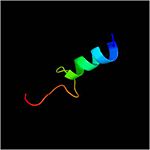Mycobacterium tuberculosis ArfA Rv0899
From Proteopedia
(Difference between revisions)
| Line 21: | Line 21: | ||
= Function == | = Function == | ||
| - | + | The membrane protein Rv0899 ArfA from '''''Mycobacterium tuberculosis''''' [http://he.wikipedia.org/wiki/Mycobacterium_tuberculosis] belongs to the OmpA (outer membrane protein A) family of outer membrane proteins and has been proposed to act as an outer membrane [[porin]] and to contribute to the bacterium's adaptation to the acidic environment of the phagosome[http://en.wikipedia.org/wiki/Phagosome] during infection.The deletion of this gene impairs the uptake of some water-soluble substances, such as serine, glucose, and glycerol.Using [[NMR]] chemical shift perturbation and isothermal calorimetric titration assays, Rv0899 was able to interact with <scene name='61/612805/Binding-site_for_zn/1'>Zn(2+) ions</scene>, which may indicate a role for Rv0899 in the process of Zn(2+) acquisition. | |
<ref>PMID: 22108166 </ref> | <ref>PMID: 22108166 </ref> | ||
''Mycobacterium tuberculosis'' ArfA (Rv0899) is a membrane protein encoded by an ammonia release facilator operon that is necessary for rapid ammonia secretion, pH neutralization and adaptation to acidic environments in vitro. Its C-terminal domain (C domain) shares significant sequence homology with the OmpA-like family of peptidoglycan-binding domains, suggesting that its physiological function in acid stress protection may be related to its interaction with the mycobacterial cell wall. It exhibits pH-dependent conformational dynamics (with significant heterogeneity at neutral pH and a more ordered structure at acidic pH), which could be related to its acid stress response. The C domain associates tightly with polymeric peptidoglycan isolated from ''Mycobacterium tuberculosis''. Its functions in acid stress protection and <scene name='61/612805/The_peptidoglycan_binding_site/1'>peptidoglycan binding</scene> suggest a link between the acid stress response and the physicochemical properties of the mycobacterial cell wall.<ref>PMID: 22206986 </ref>. | ''Mycobacterium tuberculosis'' ArfA (Rv0899) is a membrane protein encoded by an ammonia release facilator operon that is necessary for rapid ammonia secretion, pH neutralization and adaptation to acidic environments in vitro. Its C-terminal domain (C domain) shares significant sequence homology with the OmpA-like family of peptidoglycan-binding domains, suggesting that its physiological function in acid stress protection may be related to its interaction with the mycobacterial cell wall. It exhibits pH-dependent conformational dynamics (with significant heterogeneity at neutral pH and a more ordered structure at acidic pH), which could be related to its acid stress response. The C domain associates tightly with polymeric peptidoglycan isolated from ''Mycobacterium tuberculosis''. Its functions in acid stress protection and <scene name='61/612805/The_peptidoglycan_binding_site/1'>peptidoglycan binding</scene> suggest a link between the acid stress response and the physicochemical properties of the mycobacterial cell wall.<ref>PMID: 22206986 </ref>. | ||
| Line 29: | Line 29: | ||
== Disease == | == Disease == | ||
| - | + | ||
The protein is restricted to pathogenic Mycobacteria associated with TB and, thus, is an attractive candidate for the development of anti-TB chemotherapeutic agents.Two M. tuberculosis H37Rv genes (Rv0900 and Rv0901) adjacent to Rv0899 also encode putative membrane proteins, and are found exclusively in association with Rv0899 in the same pathogenic mycobacteria, suggesting that the three may constitute an operon dedicated to a common function. | The protein is restricted to pathogenic Mycobacteria associated with TB and, thus, is an attractive candidate for the development of anti-TB chemotherapeutic agents.Two M. tuberculosis H37Rv genes (Rv0900 and Rv0901) adjacent to Rv0899 also encode putative membrane proteins, and are found exclusively in association with Rv0899 in the same pathogenic mycobacteria, suggesting that the three may constitute an operon dedicated to a common function. | ||
The amino acid pair <scene name='61/612805/Asn111_and_gly112/1'>Asn111-Gly112</scene>,located at the end of α1 and preceding L3, undergoes in-vitro deamidation, a pH-dependent reaction whereby Asn is converted to Asp and ammonia is released. Asparagine residues preceding glycine, and situated in conformationally flexible regions of proteins, are frequently deamidated, with potentially significant consequences for protein regulation and function. In the case of Rv0899, deamidation and the concomitant release of ammonia could have important consequences for the acid adaptation function of the protein. The gene is restricted to pathogenic mycobacteria and, thus, is an attractive candidate for the development of anti-tuberculosis chemotherapy. <ref>PMID: 20199110</ref> | The amino acid pair <scene name='61/612805/Asn111_and_gly112/1'>Asn111-Gly112</scene>,located at the end of α1 and preceding L3, undergoes in-vitro deamidation, a pH-dependent reaction whereby Asn is converted to Asp and ammonia is released. Asparagine residues preceding glycine, and situated in conformationally flexible regions of proteins, are frequently deamidated, with potentially significant consequences for protein regulation and function. In the case of Rv0899, deamidation and the concomitant release of ammonia could have important consequences for the acid adaptation function of the protein. The gene is restricted to pathogenic mycobacteria and, thus, is an attractive candidate for the development of anti-tuberculosis chemotherapy. <ref>PMID: 20199110</ref> | ||
Revision as of 18:14, 15 January 2015
| |||||||||||


